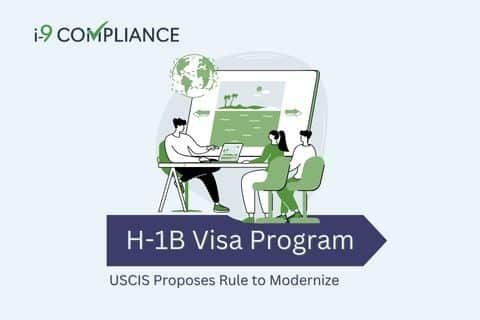USCIS Proposes Rule to Modernize the H-1B Visa Program

November 03, 2023
The U.S. Citizenship and Immigration Services (USCIS) recently posted a proposed regulation to modernize the H-1B visa program. This proposed rule would significantly change the requirements and procedures governing the H-1B process. As such, it would have broad implications for applicants and their potential employers.
Now publicly available, the proposed rule has appeared on the Federal Register as of October 23, 2023. According to USCIS and the Department of Homeland Security (DHS), this rule would “amend its regulations governing H-1B specialty occupation workers to modernize and improve the efficiency of the H-1B program, add benefits and flexibilities, and improve integrity measures.”
The proposed changes would make many alterations to the program, modernizing and improving its efficiency. A key detail includes revising the current definition of a “specialty occupation.” According to the rule, a position may permit a range of degrees to qualify. As a result, the primary requirement is for the degree to possess a direct relationship with the field/fields and the particular duties of the position.
The agency also seeks to eliminate confusion when filing petitions and amended petitions. One example concerns material changes that require new labor condition applications (LCAs). The affected must file an amended petition with the LCA. In addition, the USCIS requires an amended petition due to changes in the geographical area of employment. Furthermore, the DHS intends to codify its existing policy to previously approved petitions when there are no material changes.
The USCIS also proposed changes to help organizations and beneficiaries avoid gaps in employment. For example, it would revise the requirements beneficiaries must meet to qualify for cap exemption. Making these changes would add greater benefits and flexibility to the program. In addition, individuals must currently spend “the majority of” their time working for a qualifying cap-exempt entity. However, the USCIS intends to change this to only “at least half.”
The agency also intends to eliminate “cap gaps” in employment that affect F-1 students seeking H-1B status. To do this, the USCIS proposed an extended F-1 status and associated work authorization. This extension would run from October 1 to April 1 of the appropriate fiscal year.
Another goal is to reduce fraud and improve the program’s integrity by altering how it selects registrations. Instead of selecting individuals by each unique registration, the program would choose based on individual beneficiaries. As such, the number of filed registrations will not affect a beneficiary’s chances. This change would ensure equal opportunity for each beneficiary.
These are only the most significant changes the USCIS proposed. However, the agency may make alterations before implementing the rule. The public will have the chance to comment on these proposed changes for 60 days following October 23, 2023.
In addition to keeping an eye on these potential changes, employers should remain focused on other critical areas of compliance. One example includes the employment eligibility verification (Form I-9) process, which can become a minefield for litigation and civil fines. One way to ensure uniform compliance is to use an electronic I-9 management tool with E-Verify integration. This tool can provide step-by-step guidance, securely store documents, and provide alerts of when to take action.
Learn more about automating your employment eligibility verification and ensuring compliance with I-9Compliance.